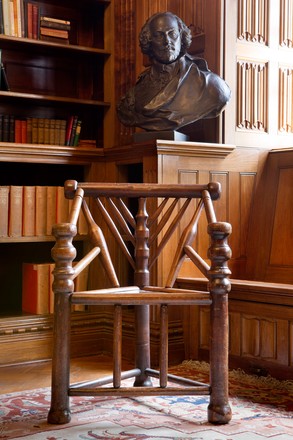
‘Shakespeare’s Wood’ chair
1800s
English oak with mulberry insertion
Bequest of Bertram Howell, 1961
English oak with mulberry insertion
Bequest of Bertram Howell, 1961
Embedded in the top rail of this unusual three-legged chair is a slip of mulberry wood stamped with the words ‘Shakespeares wood.’ It is believed that this piece of wood is from a mulberry tree which Shakespeare planted in his garden at Stratford-upon-Avon.
The armchair is made from three upright posts, which support a flat, triangular seat made from a single plank housed within a triangular frame. Each post has numerous turnings which terminate in ball finials and feet. All are joined below the seat by turned cylindrical stretchers. Supporting the cylindrical top rail, either side of the back post, are six small slanted spindles with tapered turnings decorated with simple incised grooves forming a back rest, while the turned cylindrical arm rests run from each end of the top rail to below the ball finials of the front uprights. Each arm is supported by a large turned spindle fixed into the triangular seat frame. The design is based on the earlier Edward III style, popular in the 14th century.


 Back to list
Back to list